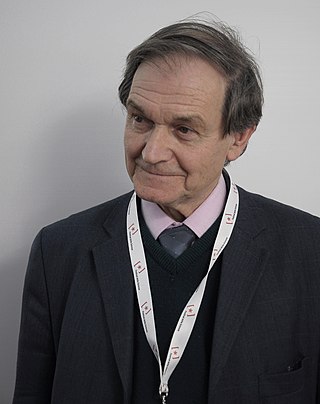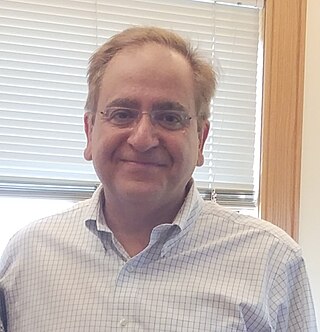
Quantum information is the information of the state of a quantum system. It is the basic entity of study in quantum information theory, and can be manipulated using quantum information processing techniques. Quantum information refers to both the technical definition in terms of Von Neumann entropy and the general computational term.

Sir Roger Penrose is an English mathematician, mathematical physicist, philosopher of science and Nobel Laureate in Physics. He is Emeritus Rouse Ball Professor of Mathematics in the University of Oxford, an emeritus fellow of Wadham College, Oxford, and an honorary fellow of St John's College, Cambridge, and University College London.

A theory of everything (TOE), final theory, ultimate theory, unified field theory or master theory is a hypothetical, singular, all-encompassing, coherent theoretical framework of physics that fully explains and links together all aspects of the universe. Finding a theory of everything is one of the major unsolved problems in physics.
The de Broglie–Bohm theory, also known as the pilot wave theory, Bohmian mechanics, Bohm's interpretation, and the causal interpretation, is an interpretation of quantum mechanics. It postulates that in addition to the wavefunction, an actual configuration of particles exists, even when unobserved. The evolution over time of the configuration of all particles is defined by a guiding equation. The evolution of the wave function over time is given by the Schrödinger equation. The theory is named after Louis de Broglie (1892–1987) and David Bohm (1917–1992).
Charge, parity, and time reversal symmetry is a fundamental symmetry of physical laws under the simultaneous transformations of charge conjugation (C), parity transformation (P), and time reversal (T). CPT is the only combination of C, P, and T that is observed to be an exact symmetry of nature at the fundamental level. The CPT theorem says that CPT symmetry holds for all physical phenomena, or more precisely, that any Lorentz invariant local quantum field theory with a Hermitian Hamiltonian must have CPT symmetry.

Cumrun Vafa is an Iranian-American theoretical physicist and the Hollis Professor of Mathematicks and Natural Philosophy at Harvard University.
Quantum information science is a field that combines the principles of quantum mechanics with information theory to study the processing, analysis, and transmission of information. It covers both theoretical and experimental aspects of quantum physics, including the limits of what can be achieved with quantum information. The term quantum information theory is sometimes used, but it does not include experimental research and can be confused with a subfield of quantum information science that deals with the processing of quantum information.

Calculating Space is Konrad Zuse's 1969 book on automata theory. He proposed that all processes in the universe are computational. This view is known today as the simulation hypothesis, digital philosophy, digital physics or pancomputationalism. Zuse proposed that the universe is being computed by some sort of cellular automaton or other discrete computing machinery, challenging the long-held view that some physical laws are continuous by nature. He focused on cellular automata as a possible substrate of the computation, and pointed out that the classical notions of entropy and its growth do not make sense in deterministically computed universes.
In theoretical physics, the Coleman–Mandula theorem is a no-go theorem stating that spacetime and internal symmetries can only combine in a trivial way. This means that the charges associated with internal symmetries must always transform as Lorentz scalars. Some notable exceptions to the no-go theorem are conformal symmetry and supersymmetry. It is named after Sidney Coleman and Jeffrey Mandula who proved it in 1967 as the culmination of a series of increasingly generalized no-go theorems investigating how internal symmetries can be combined with spacetime symmetries. The supersymmetric generalization is known as the Haag–Łopuszański–Sohnius theorem.

Rudolf Haag was a German theoretical physicist, who mainly dealt with fundamental questions of quantum field theory. He was one of the founders of the modern formulation of quantum field theory and he identified the formal structure in terms of the principle of locality and local observables. He also made important advances in the foundations of quantum statistical mechanics.
In physics and cosmology, the mathematical universe hypothesis (MUH), also known as the ultimate ensemble theory, is a speculative "theory of everything" (TOE) proposed by cosmologist Max Tegmark.
In quantum mechanics, superdeterminism is a loophole in Bell's theorem. By postulating that all systems being measured are correlated with the choices of which measurements to make on them, the assumptions of the theorem are no longer fulfilled. A hidden variables theory which is superdeterministic can thus fulfill Bell's notion of local causality and still violate the inequalities derived from Bell's theorem. This makes it possible to construct a local hidden-variable theory that reproduces the predictions of quantum mechanics, for which a few toy models have been proposed. In addition to being deterministic, superdeterministic models also postulate correlations between the state that is measured and the measurement setting.
Einstein–Cartan–Evans theory or ECE theory was an attempted unified theory of physics proposed by the Welsh chemist and physicist Myron Wyn Evans, which claimed to unify general relativity, quantum mechanics and electromagnetism. The hypothesis was largely published in the journal Foundations of Physics Letters between 2003 and 2005. Several of Evans's central claims were later shown to be mathematically incorrect and, in 2008, the new editor of Foundations of Physics, Nobel laureate Gerard 't Hooft, published an editorial note effectively retracting the journal's support for the hypothesis.
Categorical quantum mechanics is the study of quantum foundations and quantum information using paradigms from mathematics and computer science, notably monoidal category theory. The primitive objects of study are physical processes, and the different ways that these can be composed. It was pioneered in 2004 by Samson Abramsky and Bob Coecke. Categorical quantum mechanics is entry 18M40 in MSC2020.
Norman H. Margolus is a Canadian-American physicist and computer scientist, known for his work on cellular automata and reversible computing. He is a research affiliate with the Computer Science and Artificial Intelligence Laboratory at the Massachusetts Institute of Technology.

In computer science, a digital electronic computer is a computer machine which is both an electronic computer and a digital computer. Examples of digital electronic computers include the IBM PC, the Apple Macintosh, and modern smartphones. When computers that were both digital and electronic appeared, they displaced almost all other kinds of computers, but computation has historically been performed in various non-digital and non-electronic ways: the Lehmer sieve is an example of a digital non-electronic computer, while analog computers are examples of non-digital computers which can be electronic, and mechanical computers are examples of non-electronic computers.
In theoretical physics, the problem of time is a conceptual conflict between general relativity and quantum mechanics in that quantum mechanics regards the flow of time as universal and absolute, whereas general relativity regards the flow of time as malleable and relative. This problem raises the question of what time really is in a physical sense and whether it is truly a real, distinct phenomenon. It also involves the related question of why time seems to flow in a single direction, despite the fact that no known physical laws at the microscopic level seem to require a single direction.
Peter Christopher West, born on 4 December 1951, is a British theoretical physicist at King's College, London and a fellow of the Royal Society.

Klaus Fredenhagen is a German theoretical physicist who works on the mathematical foundations of quantum field theory.







